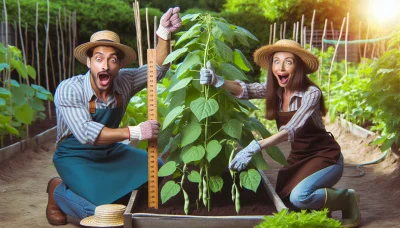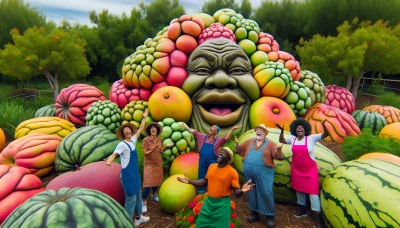Ginkgo seeds Quiz
Test Your Knowledge
Question of
Introduction to Ginkgo Seeds
Ginkgo seeds come from the Ginkgo biloba tree, which is one of the oldest living tree species globally. These seeds have been harvested and valued for their culinary and medicinal properties for centuries, particularly in East Asian cultures. In gardening, ginkgo seeds are significant due to their potential to grow into ginkgo trees, known for their unique fan-shaped leaves and remarkable resilience to environmental stressors. Planting ginkgo seeds can add a touch of ancient history and beauty to any garden, making them a fascinating choice for gardeners looking to cultivate something truly unique.
The History of Ginkgo Biloba
Ginkgo biloba, often simply known as ginkgo, is one of the oldest living tree species, with a history that dates back over 270 million years. Originating in China, ginkgo biloba has been used in traditional Chinese medicine for thousands of years, and its seeds are thought to have been consumed as a food source even earlier. The tree is highly respected and considered a symbol of endurance and vitality, as it can live for thousands of years and is remarkably resilient to environmental stressors. Ancient texts document its medicinal use for improving memory, treating circulatory disorders, and as a general tonic to enhance wellness. Its leaves and seeds have been used in various forms, from teas to extracts, demonstrating the deep historical significance and enduring value of ginkgo biloba in human health and culture.
How to Plant Ginkgo Seeds
- Collect the Seeds: Wait for the ginkgo seeds to fall from the tree or gently remove them when they are ripe and soft.
- Clean the Seeds: Remove the outer fleshy layer of the seeds, which can be messy and smelly. Wear gloves to protect your hands.
- Stratify the Seeds: Since ginkgo seeds require a period of cold stratification to germinate, mix them with moist sand and store them in a refrigerator for 2-3 months.
- Prepare the Soil: Ginkgo trees prefer well-draining soil. Mix garden soil with some sand and compost to improve drainage and fertility.
- Choose the Right Location: Ginkgo trees need plenty of sunlight to thrive. Select a planting spot that receives full sun to partial shade.
- Plant the Seeds: After the stratification period, plant the seeds 1-2 inches deep in the prepared soil. Make sure the pointed end of the seed is facing downwards.
- Water Regularly: Keep the soil moist but not waterlogged. Ginkgo seeds need consistent moisture to germinate successfully.
- Wait for Germination: It can take a few weeks to a few months for ginkgo seeds to germinate. Be patient and keep the soil conditions consistent.
- Transplant Seedlings: Once the seedlings have grown a few inches tall and have developed several sets of leaves, they can be transplanted to their final location in the garden or into larger pots.
Caring for Your Ginkgo Seedlings
Ginkgo seedlings require careful attention to thrive. They should be watered deeply but infrequently, allowing the soil to dry out slightly between waterings. This mimics the natural precipitation patterns they would experience in their native habitat. Ginkgo seedlings need ample sunlight, with at least 4-6 hours of direct sunlight each day, to ensure healthy growth. When it comes to soil, they prefer well-draining soil with a slightly acidic to neutral pH. Incorporating organic matter into the planting site can improve soil structure and nutrient content, supporting the healthy development of your ginkgo seedlings.
Common Challenges in Growing Ginkgo
- Pests: Ginkgo trees can sometimes attract pests such as scale insects and ginkgo aphids. Regular monitoring and the use of horticultural oils or insecticidal soaps can be effective in managing these pests.
- Diseases: While ginkgo trees are generally resistant to most diseases, they can occasionally suffer from root rot if the soil does not drain well. Ensuring proper drainage and avoiding overwatering are key preventive measures.
- Germination Problems: Ginkgo seeds have a hard outer shell that can make germination challenging. To improve germination rates, practice scarification by gently filing the seed coat before soaking the seeds in water for a day or two. Planting them in a well-draining soil mix and maintaining consistent moisture without overwatering can also help improve germination success.
The Benefits of Ginkgo Trees in Your Garden
Ginkgo trees, with their distinctive fan-shaped leaves and robust nature, offer a myriad of benefits when planted in your garden. Environmentally, they are known to be exceptionally resilient, tolerating pollution and confined soil spaces, making them ideal for urban gardens. Their leaves provide a thick canopy during summer, creating a natural cooling effect that can reduce the need for air conditioning. In autumn, their foliage turns a brilliant yellow, adding a spectacular display of color to your garden. Aesthetically, ginkgo trees add a touch of elegance and ancient history, as they are among the oldest living tree species in the world. Their unique form and seasonal color changes can enhance the visual appeal of any garden, making them a favorite among garden enthusiasts and landscape designers alike.
Conclusion: The Joy of Growing Ginkgo from Seeds
Growing ginkgo from seeds represents a truly rewarding endeavor for gardeners of all levels. The process, which requires patience and care, culminates in the emergence of a unique and ancient tree that can live for centuries, offering a living legacy of one's gardening passion. The satisfaction derived from nurturing a ginkgo tree from its very inception, witnessing its slow but steady growth, and eventually seeing it flourish, is unparalleled. It's a testament to the gardener's dedication and a source of endless joy. We encourage everyone to embark on this remarkable journey of growing ginkgo from seeds, to not only enhance their gardens but to connect with a piece of living history.












